
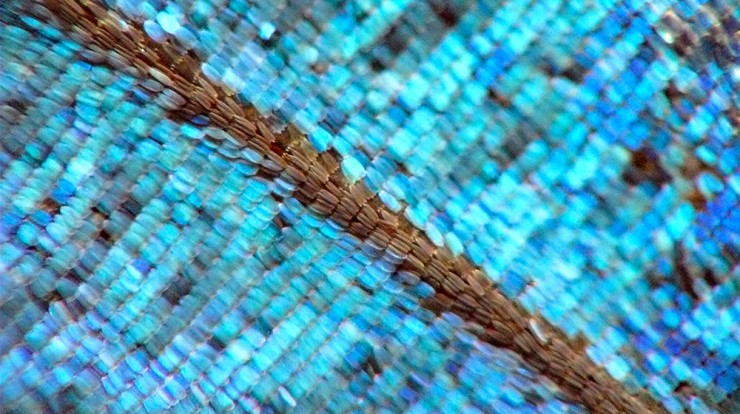
Features
Biomimicry and Photonics
Cas Smith
Share
Learn more about our bioinspired innovation work and services by emailing us at [email protected] and reading our report, Tapping into Nature. Follow the conversation on twitter: @TerrapinBG | @NY_biomimicry | #TapNature.
Organisms employ an array of strategies to generate, detect, absorb, scatter, and otherwise process light. Researchers in optics and photonics are studying these strategies and increasingly use them as blueprints in the development of advanced sensing and imaging devices.
Butterfly Wings Inspire Advanced Sensor Technologies
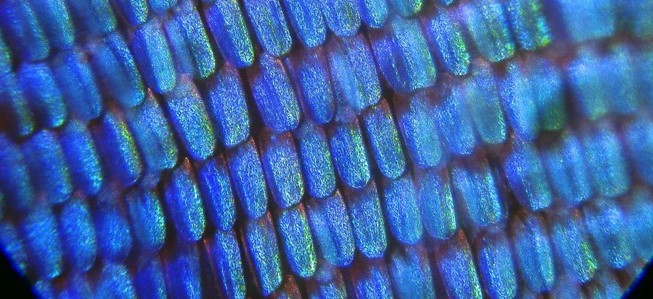
The scales on a wing of a Blue Morpho butterfly attain their hues through structural color. Copyright Grover Schrayer/Flickr.
The wings of Morpho butterflies produce bright, vibrant, iridescent colors when light interacts with the micro- and nanoscale architecture of the wing scales. Each scale is made of chitin—an abundant biopolymer—and supports an array of parallel ridges. In cross-section, each individual ridge shows a periodic nano-scale structure consisting of vertical and horizontal struts, resembling the shape of a tree. The iridescence of the Morpho wings is produced by light interference on the horizontal sections and by light diffraction on the vertical portions.
New research on the color of Morpho wings at GE Global Research has determined that the scales also have an optical response to changes in thermal energy. Absorption of infrared (IR) radiation and the subsequent conversion to thermal energy by the chitin results in an expansion of the nanostructure; this morphological change produces an observable change in the wing’s iridescence.
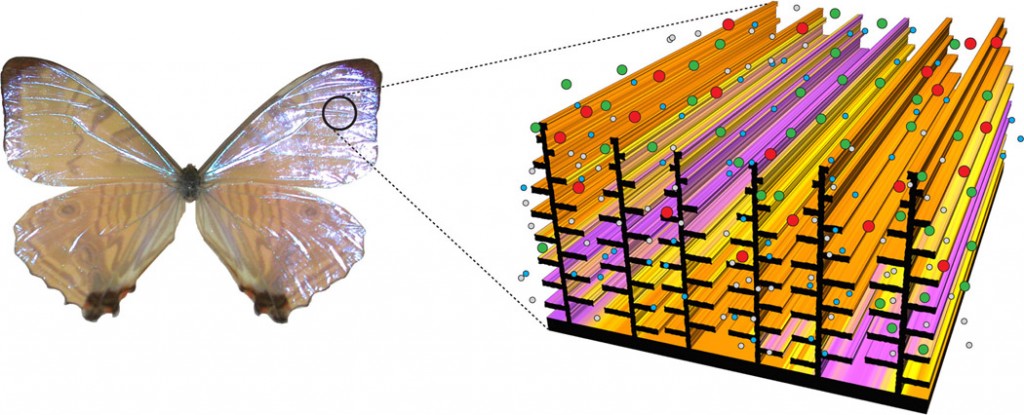
Representation of the chitin nanostructure seen in butterfly wings. Copyright Radislav A. Potyrailo.
The speed and sensitivity with which the layered wing scales react to IR photons were previously unattainable in manufactured sensors. Scientists are now developing thermal sensors based on the nanoscale structure of Morpho wings to improve not only response speed and thermal sensitivity but also to reduce the pixel size. Studies are also in progress to evaluate the vapor-response selectivity of the nanoscale structure of Morpho wings. Continued research on Morpho wings may spur a new generation of sensor technologies.
Compound Eye of Nocturnal Insects Inspires Anti-Reflective Nanoscale Surfaces
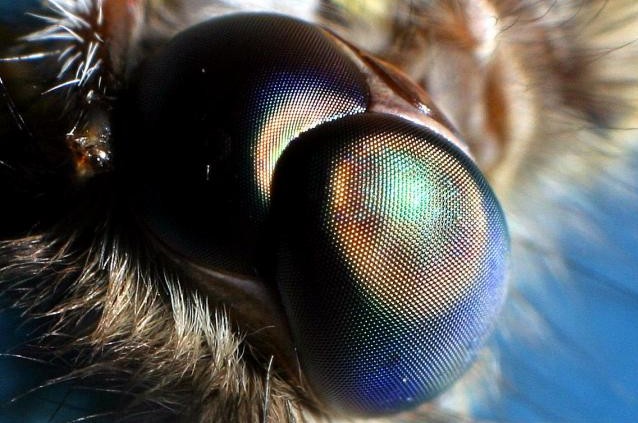
The photonic structure of moth eyes not only heightens their sense of sight but also decreases their detection by nocturnal predators. Copyright Rick Cowen.
Nocturnal moths are able to see at night because their eyes absorb a high proportion of light instead of reflecting it. Made of nanoscale structures in a hexagonal lattice, this architecture advantageously directs incident light to increase the insect’s light sensitivity and to decrease external reflection visible to predators. The two components responsible for this light interaction are the tapetal mirror and the corneal nipple array. The tapetal mirror situated behind the moth eye’s photoreceptors allows light to reflect back through the eye structure, providing two opportunities to absorb incoming photons. The corneal nipple array— otherwise known as the “moth-eye” structure—covers the micron-sized facets of the eye and acts as an anti-reflective coating. As a result, the moth is able to see in very low light conditions. Additionally, because the nanostructure of the eye absorbs such a high degree of light, the compound eye reflects little incident light, protecting it from detection by predators.
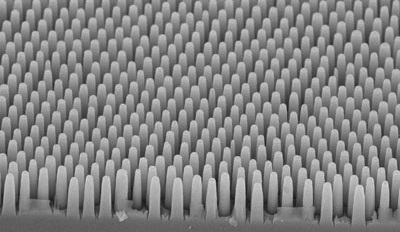
A manufactured anti-reflective “moth-eye” silicon film viewed through an electron microscope. Copyright Wei-Lun Min.
Researchers at Nagaoka University of Technology in Japan have shown that applying anti-reflective “moth-eye” films onto existing solar panels increases the conversion of incident photons to usable electricity by 5%. Additionally, manufacturing techniques have been developed by researchers in the United States to incorporate moth-eye nanostructures in solar cells during their production, yielding increased solar cell efficiency.
Tropical Seeds Inspire Smart Materials
Of the many fruits and seeds in tropical forests that have striking colors to encourage seed dispersal, Margaritaria nobilis has a unique color strategy. The blue-green hue attracts birds to eat and disperse the seeds even though they have low nutritional value. The color and luster of M. nobilis seeds are due to a hierarchical photonic structure. The seed coat contains cells whose interiors are composed of concentrically layered tissue. When light interacts with these layers, it is reflected as blue or green light due to optical interference. The angle of incidence and seed curvature—both microscopic and macroscopic—also account for the multihued reflections.
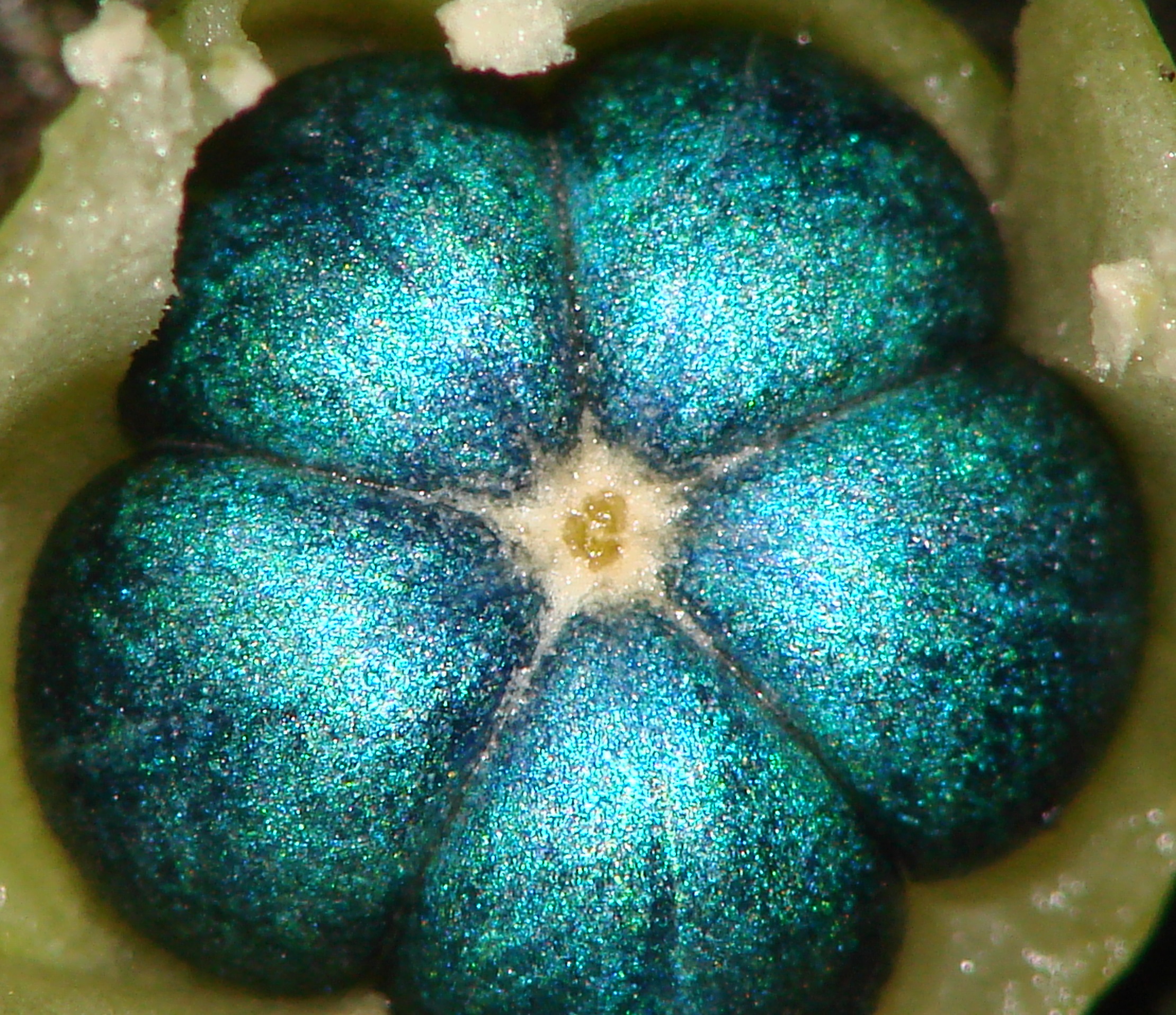
The brilliance of Margaritaria nobilis seeds is derived from concentrically layered tissue. Copyright Herbario UCO.
The concentrically layered cell architecture of the Margaritaria nobilis has inspired the development of a photonic fiber that reflects varying colors when stretched. The lab-scale fabrication process includes a rolling technique that creates a multilayer cladding around a central flexible fiber. These concentric multilayers—formed using two different materials—result in a photonic structure due to the materials’ different refractive indices. Unlike in conventional thermal drawing processes, these multilayer fibers are produced at room temperature, which allows fabrication with a wide range of polymers.
Cephalopod Skin Inspires Display Materials
Certain species of octopus, squid, and cuttlefish are able to blend into their surroundings, camouflaging themselves to protect against predators. This ability is due to the unique combination of pigments and photonic structures in the skin of cephalopods. The intricate interaction of these optical elements—chromatophores, iridophores, and leucophores—allows the animals to alter their appearance. Chromatophores are small pigment-containing organs that are capable of dynamic, neurologically-controlled changes in volume. Their pigmentation provides varying hues of red, brown, black, orange, and yellow. Iridophore cells feature a photonic structure that reflects blue and green colors. While many artificial photonic structures (e.g. diffraction gratings) are static, cephalopods are capable of modulating their iridophores to vary the reflected colors. The final aspect of their camouflage is the reflection of incident light. Leucophore cells—which contain light-scattering protein spheres—allow cephalopods to reflect white light. Together, all of these optical devices allow the organisms to display a wide palette of colors.

Pigments and photonic structures allow rapid, dynamic color change in cephalopods. Copyright Roger Hanlon.
Technologies that feature cephalopods’ optical tricks include photonic gels that may be used in future electronic displays. Using the iridophores as inspiration, researchers in the United States are developing tunable photonic-crystal pixels for display applications. Electronic displays using these dynamic, diffraction grating pixels would not require rear or peripheral lighting systems to illuminate the pixel; instead, ambient light is the light source. A new generation of low-energy flat panel displays may be made possible from this research.
Spider Webs Inspire Bird-Safe Glass
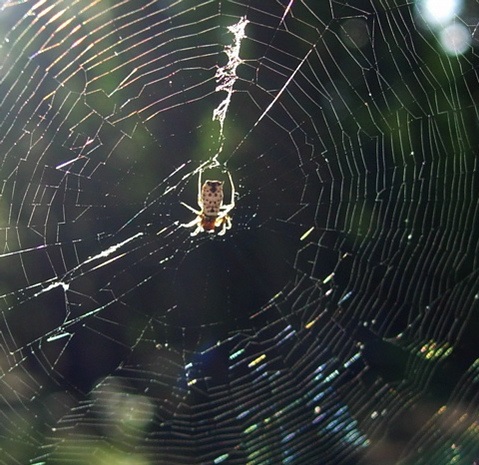
Ultraviolet light reflects off the center of spider webs and allows birds in flight to avoid collision, benefiting both bird and spider. Copyright spiderkakes/Flickr.
A spider’s ability to protect its web from predators has recently inspired the development of window glass that prevents birds from striking it. Research conducted on the decorative patterns of spider webs, technically known as the stabilimenta, found that the center decorations serve as a warning signal to birds. Birds are capable of perceiving ultraviolet light reflecting off the silk and altering their path to avoid the webs. Depending on the direction of light, spiders create denser designs to provide more surface area for reflection. Studies indicate that the presence of a decorative center on spider webs reduces damage from flying birds.
The reflectivity of the stabilimenta inspired a company in California, Arnold Glas, to design an insulated glass sheet called ORNILUX. The glass has a unique ultraviolet-reflective coating that appears almost transparent to humans but is clearly perceptible to birds. The coating mimics the reflectivity and patterns of spider silk. The use of ORNILUX reduces bird collisions by 77% compared to standard window glass.
*Header and feature image copyright robbersdog/Flickr
Morpho References:
Potyrailo et al., “Morpho butterfly wing scales demonstrate highly selective vapor response,” Nature Photonics, DOI: 10.1038/nphoton.2007.2
Pris et al., “Towards high-speed imaging of infrared photons with bio-inspired nanoarchitectures,” Nature Photonics, DOI: 10.1038/nphoton.2011.355
Potyrailo et al., “Discovery of the surface polarity gradient on iridescent Morpho butterfly scales reveals a mechanism of their selective vapor response,” PNAS, DOI: 10.1073/pnas.1311196110
Moth-eye References:
Takemura et al., “Absence of eye shine and tapetum in the heterogeneous eye of Anthocharis butterflies (Pieridae),” Journal of Experimental Biology, DOI: 10.1242/?jeb.002725
Yamada et al., “Characterization of antireflection moth-eye film on crystalline silicon photovoltaic module,” Optics Express, DOI: 10.1364/OE.19.00A118
Sun et al., “Broadband moth-eye antireflection coatings on silicon,” Applied Physics Letters, DOI: 10.1063/1.2870080
M. nobilis References:
Kolle et al., “Bio-Inspired Band-Gap Tunable Elastic Optical Multilayer Fibers,” Advanced Materials, DOI: 10.1002/adma.201203529
Cazetta et al., “Frugivory on Margaritaria nobilis L.f. (Euphorbiaceae): poor investment and mimetism,” Brazilian Journal of Botany, DOI: 10.1590/S0100-84042008000200012
Cephalopod References:
Mäthger et al., “Mechanisms and behavioral functions of structural coloration in cephalopods,” Journal of the Royal Society Interface, DOI: 10.1098/?rsif.2008.0366.focus
Walish et al., “Bioinspired electrochemically tunable block copolymer full color pixels,” Advanced Materials, DOI: 10.1002/adma.200900067
Crookes et al., “Reflectins: The Unusual Proteins of Squid Reflective Tissues,” Science, DOI: 10.1126/science.1091288
Spider Web References:
Bruce et al., “Spider signals: Are web decorations visible to birds and bees?” Biology Letters, DOI: 10.1098/rsbl.2005.0307
Herberstein and Fleisch, “Effect of abiotic factors on the foraging strategy of the orb-web spider Argiope keyserlingi (Araneae: Araneidae),” Austral Ecology, DOI: 10.1046/j.1442-9993.2003.t01-1-01319.x
Eisner and Nowicki, “Spider web protection through visual advertisement: role of the stabilimentum,” Science, DOI: 10.1126/science.219.4581.185
Ley, “Experimentelle Tests zur Wahrnehmbarkeit von UV-reflektierenden “Vogelschutzgläsern” durch mitteleuropäische Singvögel,” Berichte zum Vogelschutz, vol. 43, pp. 87-91, 2006.
Cas Smith
Cas is a biological engineer with a passion for technology based in and inspired by biology. He served as the project manager for Terrapin's technology development services. Cas believes that using biotechnology will lead to a more bountiful and prosperous world for all living things.
Topics
- Occupant Comfort
- Materials Science
- Speaking
- LEED
- Terrapin Team
- Phoebe
- Community Development
- Greenbuild
- Technology
- Biophilic Design Interactive
- Catie Ryan
- Spanish
- Hebrew
- French
- Portuguese
- Publications
- Carbon Neutrality
- Environmental Values
- Conference
- Psychoacoustics
- Education
- Workshop
- Mass Timber
- Transit
- Carbon Strategy
- connection with natural materials
- interior design
- inspirational hero
- biophilia
- economics of biophilia
- Sustainability
- Systems Integration
- Biophilic Design
- Commercial
- Net Zero
- Resorts & Hospitality
- Energy Utilization
- Water Management
- Corporations and Institutions
- Institutional
- Ecosystem Science
- Green Guidelines
- Profitability
- Climate Resiliency
- Health & Wellbeing
- Indoor Environmental Quality
- Building Performance
- Bioinspired Innovation
- Biodiversity
- Residential
- Master Planning
- Architects and Designers
- Developers and Building Owners
- Governments and NGOs
- Urban Design
- Product Development
- Original Research
- Manufacturing
- Industrial Ecology
- Resource Management
- Sustainability Plans
- Health Care


